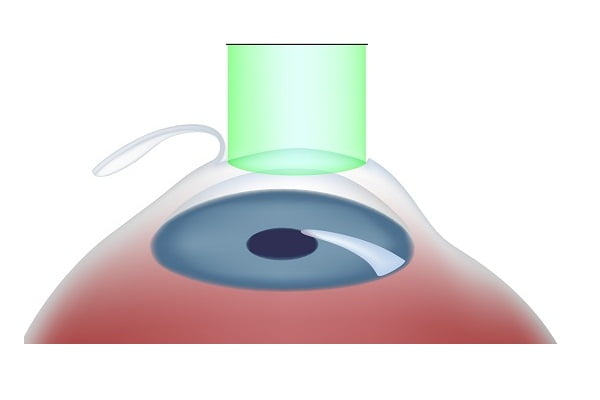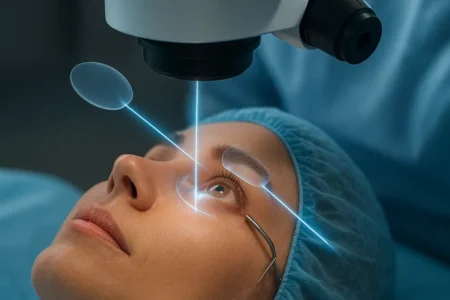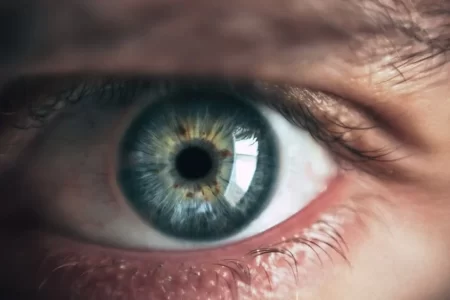
What is LASIK (Laser Assisted in Situ Keratomileusis) or laser eye surgery?
LASIK (Laser Assisted in Situ Keratomileusis), also called laser eye surgery or laser vision correction, is the most common type of laser eye surgery used to treat different eye problems like nearsightedness, farsightedness, and astigmatism. It is a type of refractive surgery.
The cornea of the eye is reshaped in order to attain vision correction during a LASIK procedure. The main objective of a LASIK surgery is to:
- Improve far vision by flattening the cornea.
- Improve near vision by steepening the curve of the cornea.
- Treat astigmatism by smoothing irregularity of the cornea.
A single LASIK eye surgery typically takes about 15-20 minutes. However, the total time for which the patient has to be at the doctor’s office is 1.5 -2 hours approximately.
Does laser eye surgery hurt? Is laser eye surgery painful?
In most cases, LASIK eye surgery does not hurt during or immediately after the procedure. It is because, before the LASIK eye surgery begins, surgeons use a numbing eye drop that alleviates any pain or discomfort to the eye during the procedure. However, the patient may feel some pressure on the eyes during the procedure and some discomfort after the procedure.
See also: What Is Myopia or Nearsightedness?
See also: Myopia (Nearsightedness): Causes, Risk Factors and Symptoms
Lasik surgery procedure
The LASIK surgery procedure involves a series of steps which are to be performed in order to do a successful surgery. These steps are discussed below:
Preparation for the LASIK surgery (laser eye surgery)
There are few things to be done in order to prepare the patient for the laser operation for eyes, which may include the following:
- Eye drops are applied in order to numb the eye.
- Some additional medication may be given to the patient to help him relax.
- The patient will be asked to sit in a comfortable, reclining surgical chair.
- The eyelids of the patient will be prop opened by using an instrument called a lid speculum.
Accessing the Cornea
After preparing the patient for the laser eye surgery, the next step of the LASIK procedure is to access the cornea so that the procedure can be carried out. It is done in the following way:
- A device will be used to stabilize the eye. Here, the patient may feel mild pressure which is absolutely normal.
- Next, the surgeon creates a thin flap in the cornea, which can be temporarily folded away to carry out the procedure.
- At this step, the patient may experience a blurred vision.
Reshaping the Cornea
In this step, the surgeon uses a computer-controlled excimer laser to direct the pulses of light at the eye to reshape the cornea. The patient may feel little pressure without any pain. A clicking sound of the equipment may be heard.
Completion of your LASIK eye surgery procedure
The last step of a LASIK procedure is to reposition the flap of the cornea. The flap will adjust itself and will stay in place naturally. This may take some hours to start healing.
LASIK Procedure Recovery
The surgeon will examine eyes once again after the surgery and the patient can be allowed to go home (although it is not recommended for the patient to drive). The patient may feel some sort of discomfort like an itching sensation, burning or more tear production after the surgery. However, these things are part of the healing process and are only temporary.
In most of the cases, vision is normal within eight hours and then continues to improve overtime. But sometimes, it can take several months to reach the full extent of vision improvement. If you’re considering laser eye surgery in Toronto, you have various options available to you. Toronto offers a range of clinics and providers specializing in laser eye surgery.
Why is LASIK done? Conditions in which LASIK surgery is used for treatment
LASIK surgery can be considered for the correction of these vision problems:
- Nearsightedness (myopia): in this condition, your eyeball is longer than normal or the cornea curves too sharply. This causes light rays to focus in front of the retina and blur the distant vision. People do not see far objects clearly if they have myopia.
- Farsightedness (hyperopia): In this condition, you have a shorter than average eyeball or a cornea that is too flat. This causes the light to focus behind the retina instead of on it. This makes near vision blurry.
- Astigmatism: If your cornea curves or flattens unevenly, you have a condition called astigmatism. This causes problems in the focus of near and distant vision.
Side Effects: Lasik surgery risks and complications
There are some LASIK risks and side effects which should not be ignored:
Temporary visual disturbances and discomfort after a LASIK eye surgery
A mild irritation and sensitivity to light are experienced by the patient during the first few days after the surgery. Halos, glares (especially when driving at night), hazy vision and reduced acuity of vision are some other problems faced by patients after the surgery. But all these problems are temporary and they usually disappear within three to six months.
Flap complications
In a LASIK surgery, a flap is cut on the front surface of the cornea. And then the flap is lifted during the surgery for corneal reshaping. After the surgery, the flap is again placed using a natural bandage. But, sometimes problems may arise such as listed below:
Irregular astigmatism
Irregular astigmatism occurs when the curved corneal surface is not equal. It also can occur from laser correction that is not centered properly on the eye or irregular healing of the laser correction.
The patient may suffer from double vision (diplopia) or “ghost images.” A re-treatment or enhancement surgery is always needed in such cases.
Epithelial Ingrowth
Epithelial ingrowth refers to the growth of cells from the outer layer of the cornea (epithelium) to under the flap after a LASIK surgery. Mostly, it causes no problems as it is self-limiting but in some cases, the patient may have discomfort and/or blurred vision. In order to cure this, an additional surgery is needed in which the flap is lifted and the additional cells are removed.
Diffuse lamellar keratitis (DLK)
DLK refers to the uncontrolled inflammation under the LASIK flap. Normally, the patient may experience some inflammation after a LASIK surgery, but it gets cured on its own. But an uncontrolled inflammation can interfere with healing and can even cause vision loss. In order to cure DLK, the flap is lifted and cleaned so that all the inflammatory cells are removed carefully and tissue damage is prevented.
Keratectasia or keratoconus
If during a LASIK surgery too much tissue is removed from the cornea, the eye surface may bulge. This condition is called Keratectasia or keratoconus. In order to cure keratoconus, enhancement laser surgery is usually not suitable. Instead, gas permeable contact lenses or corneal implants are prescribed because they hold the cornea in place. Corneal collagen cross-linking is also sometimes performed because it strengthens the cornea.
Dry Eyes
Dry eyes are the most common LASIK eye surgery side effects. Decreased tear production is the main cause of dry eyes and it can lead to eye irritation and vision blurring. Nearly, 50 percent of laser eye surgery patients experience varying levels of dry eye syndrome. In such cases, eye drops are suggested which lubricate the surface of your eyes. As healing continues, dry eye syndrome also disappears.
Remarkable under correction, overcorrection or regression
Not all patients achieve a 20:20 vision after the LASIK surgery. For some of them, use of glasses and contact lenses will be a necessity. And after surgery, the eyes may work optimally a few weeks but over time a regression may also be experienced due to over-healing.
Eye infection
Eye infection is rare after LASIK surgery but many eye surgeons attest that the likelihood of infections occurring is high in surgeries that use surface ablations such as PRK. A more sterile environment is created by using a natural bandage that fosters proper healing after eye laser surgery.
Can LASIK make you go blind?
LASIK complications are mostly mild and temporary and can be treated and managed. But sometimes severe complications are also experienced by some patients with eye surgery which may include significant vision loss.
In order to avoid such severe side effects it is important to keep certain things in mind which includes the following:
- Before choosing a LASIK surgeon, no doubts about the surgery should remain uncleared.
- It is important to ask plenty of questions during the eye exam and preoperative consultation to get a full knowledge about the surgery and its complications.
- The patient should always be confident and comfortable with the doctor that he will do everything possible to decrease the risk of LASIK operations.
- Always check the level of experience the doctor has in performing LASIK surgery and other vision correction procedures (PRK, phakic IOL and refractive lens exchange).
- Be very attentive to the surgeon during the pre-op consultation as he will discuss the suitability for LASIK and its specific risks which are based on a patient’s refractive error, measurements of the cornea, health and age of the patient.
- Do not hesitate to ask the surgeon about his or her policies in case of any undesirable outcome and in need of a LASIK enhancement to get better visual acuity.







1 Comment
Lasik laser eye surgery is the simplest process, there is no side effect. This is nice article, in this article explain details about lasik laser eye surgery. Kashyap memorial eye hospital provide lasik laser eye treatment or surgery.